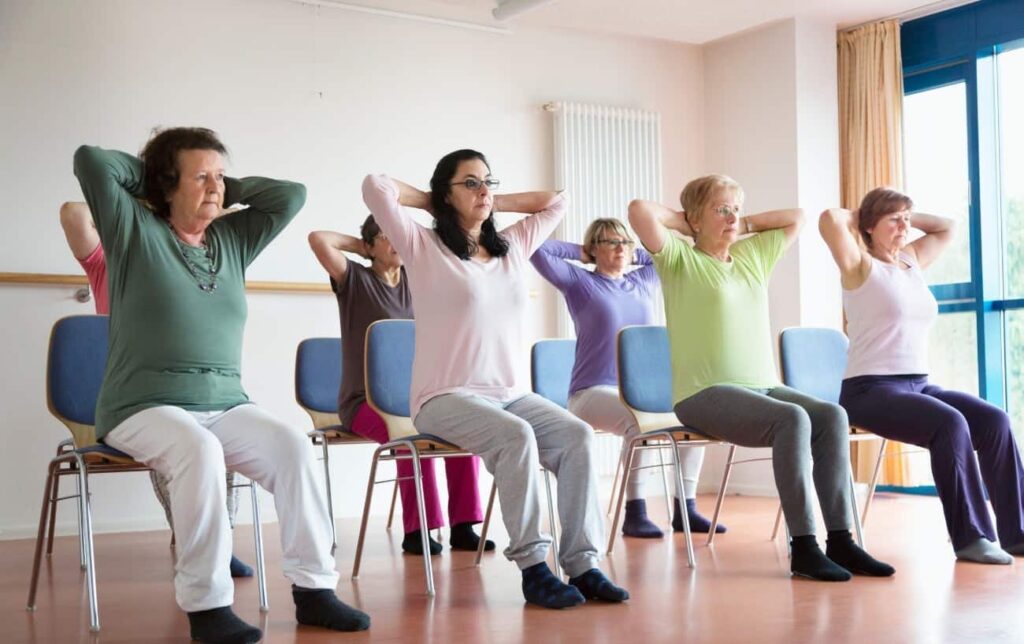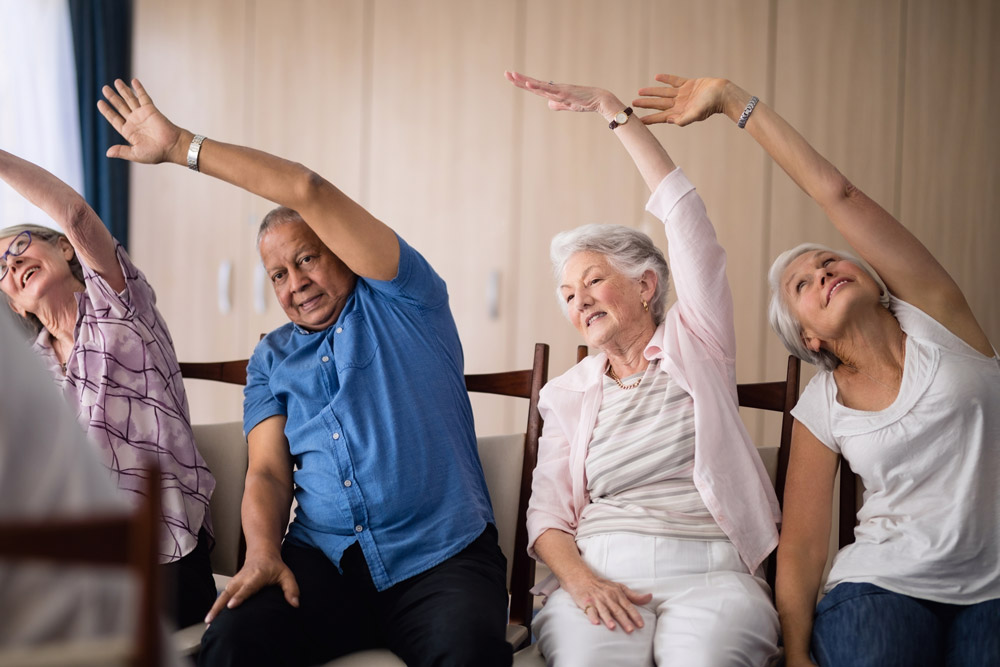Welcome to our guide on chair yoga for stress relief and relaxation! In today’s fast-paced world, stress seems to be an inevitable part of life. However, there are simple yet effective ways to manage and reduce stress, and one such method is through chair yoga. Whether you’re a beginner or an experienced yogi, chair yoga offers a gentle and accessible way to unwind, relax, and rejuvenate both the body and mind.
In this comprehensive guide, we’ll explore various chair yoga techniques and tips specifically designed to alleviate stress and promote relaxation. From breathing exercises to gentle stretches, you’ll discover how incorporating chair yoga into your daily routine can bring about a profound sense of calm and well-being.
Understanding Stress and Its Effects
Before diving into the techniques of chair yoga for stress relief, it’s essential to understand what stress is and how it affects our bodies and minds. Stress is the body’s natural response to perceived threats or demands, triggering the “fight or flight” response. While this response is crucial for survival in threatening situations, prolonged or chronic stress can have detrimental effects on our physical and mental health.
Physically, stress can manifest as muscle tension, headaches, digestive issues, and weakened immune function. Mentally, it can lead to anxiety, depression, irritability, and difficulty concentrating. Chronic stress has also been linked to an increased risk of heart disease, obesity, diabetes, and other serious health conditions.
The Benefits of Chair Yoga for Stress Relief
Chair yoga offers a myriad of benefits for stress relief and relaxation, making it an ideal practice for individuals of all ages and fitness levels. One of the primary advantages of chair yoga is its accessibility. Whether you’re recovering from an injury, dealing with mobility issues, or simply prefer a seated practice, chair yoga allows you to experience the benefits of yoga without having to get down on the floor.
Additionally, chair yoga can be practiced virtually anywhere – at home, in the office, or even while traveling. All you need is a sturdy chair and a small space to move comfortably. This accessibility makes chair yoga an excellent option for incorporating mindfulness and stress reduction into your daily routine, no matter how busy your schedule may be.
Furthermore, chair yoga offers gentle yet effective stretching and strengthening exercises that help release tension, improve flexibility, and promote relaxation. By focusing on breath awareness and mindful movement, chair yoga encourages a sense of presence and inner peace, allowing you to let go of worries and distractions.
Breathing Techniques for Stress Relief
One of the fundamental aspects of chair yoga for stress relief is breath awareness and controlled breathing techniques. Deep, diaphragmatic breathing can help activate the body’s relaxation response, counteracting the physiological effects of stress. Here are a few simple breathing exercises you can practice:
Abdominal Breathing: Sit comfortably in your chair with your feet flat on the floor. Place one hand on your abdomen and the other on your chest. Take a slow, deep breath in through your nose, allowing your abdomen to rise as you fill your lungs with air. Exhale slowly through your mouth, feeling your abdomen fall. Repeat this process several times, focusing on the sensation of your breath moving in and out of your body.
Equal Breathing: This technique involves inhaling and exhaling for an equal count, creating a balanced rhythm. Start by inhaling for a count of four, then exhale for a count of four. As you become more comfortable, you can gradually increase the duration of your inhales and exhales. This practice helps regulate the nervous system and induce a state of calm.
4-7-8 Breathing: This breathing pattern is known for its calming effects on the mind and body. Begin by exhaling completely through your mouth, making a whooshing sound. Close your mouth and inhale quietly through your nose for a count of four. Hold your breath for a count of seven, then exhale slowly through your mouth for a count of eight, making a whooshing sound again. Repeat this cycle several times, focusing on the rhythm of your breath.
Chair Yoga Poses for Stress Relief
Chair yoga poses are gentle yet effective movements that can help release tension, increase flexibility, and promote relaxation. Whether you’re sitting at your desk or unwinding at home, these poses can be easily integrated into your daily routine. Here are a few chair yoga poses specifically designed to alleviate stress:
Seated Forward Bend: Sit towards the front edge of your chair with your feet hip-width apart. Inhale as you lengthen your spine, then exhale and hinge forward from your hips, allowing your torso to fold over your thighs. Let your arms hang down towards the floor or place them on your shins for support. Hold the stretch for several breaths, feeling the gentle release of tension in your spine and hamstrings.
Seated Cat-Cow Stretch: Sit comfortably in your chair with your feet flat on the floor. Place your hands on your knees and inhale as you arch your back, lifting your chest and gaze towards the ceiling (cow pose). Exhale as you round your spine, tucking your chin towards your chest and drawing your belly button towards your spine (cat pose). Continue flowing between cat and cow pose with each inhale and exhale, syncing your movements with your breath.
Eagle Arms: Sit tall in your chair with your feet flat on the floor. Extend your arms out to the sides at shoulder height, then cross your right arm over your left, bringing your palms together (or as close as you can). Lift your elbows slightly and draw your shoulder blades down your back, feeling a stretch across your upper back and shoulders. Hold for a few breaths, then release and switch sides, crossing your left arm over your right.
Mindfulness Meditation for Stress Relief
In addition to physical movement and breathing techniques, mindfulness meditation is another powerful tool for stress relief and relaxation. Mindfulness involves paying attention to the present moment without judgment, allowing you to cultivate awareness and acceptance of your thoughts, emotions, and sensations. Here’s how you can practice mindfulness meditation in a seated position:
Body Scan Meditation: Sit comfortably in your chair with your feet flat on the floor and your hands resting on your lap. Close your eyes and take a few deep breaths to center yourself. Begin by bringing your awareness to the sensations in your body, starting from your feet and gradually moving upward. Notice any areas of tension or discomfort, and with each exhale, imagine releasing that tension and letting go. Continue scanning your body, paying attention to each part in turn, until you reach the top of your head.
Breath Awareness Meditation: Focus your attention on the sensation of your breath as it moves in and out of your body. Notice the rise and fall of your abdomen with each inhale and exhale, as well as the feeling of air passing through your nostrils. If your mind starts to wander, gently bring your focus back to your breath without judgment. Allow yourself to be fully present in the experience of breathing, letting go of any distractions or concerns.
Loving-Kindness Meditation: This meditation involves cultivating feelings of love, compassion, and kindness towards yourself and others. Begin by silently repeating phrases such as “May I be happy, may I be healthy, may I be safe, may I live with ease.” As you continue to recite these phrases, visualize yourself surrounded by love and warmth. Then, extend these wishes to others, starting with loved ones, acquaintances, and eventually all beings everywhere. Allow yourself to connect with the innate goodness within yourself and others, fostering a sense of connection and well-being.
Incorporating Chair Yoga Into Your Daily Routine
Now that you’ve learned about the various techniques of chair yoga for stress relief and relaxation, it’s time to incorporate them into your daily routine. Here are some tips for making chair yoga a regular practice:
Set Aside Time: Schedule dedicated time each day for chair yoga practice, whether it’s first thing in the morning, during your lunch break, or before bedtime. Consistency is key to experiencing the full benefits of yoga for stress relief.
Start Small: If you’re new to chair yoga, start with just a few minutes of practice each day and gradually increase the duration as you become more comfortable. Even a short session can have a positive impact on your mood and energy levels.
Listen to Your Body: Pay attention to how your body feels during chair yoga practice and modify the poses as needed to suit your comfort level. Avoid pushing yourself into Arthritis pain or uncomfortable positions, and always honor your body’s limitations.
Stay Mindful: Approach chair yoga practice with an attitude of mindfulness and self-compassion. Be present with your breath and sensations, and let go of any expectations or judgments. Remember that yoga is not about achieving perfection but rather about nurturing your body and mind with kindness and awareness.
In conclusion, chair yoga is a wonderful tool for stress relief and relaxation, offering accessible and effective techniques for promoting physical, mental, and emotional well-being. By incorporating breathing exercises, gentle stretches, and mindfulness meditation into your daily routine, you can cultivate a greater sense of calm, balance, and resilience in the face of life’s challenges.
So, why not grab a chair and give chair yoga a try today? Your body and mind will thank you for it!


